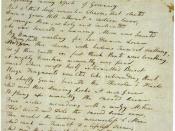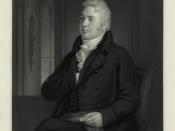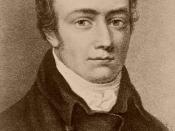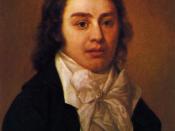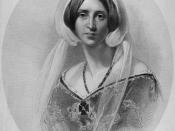ÃÂThe Eolian HarpÃÂ by Samuel Taylor Coleridge, can be described as the musings of a man thinking about his love for his wife Sara, the beauty of nature and about the wonder of God in providing him with both nature and Sara. The voice of the poem is Coleridge himself as it refers to Sara, his wife at the time of writing. It is a Romantic poem as it deals with a mixture of traditional Romantic themes: those of strong feelings, the importance of the imagination and the idea of the sublime, and the natural world.
ÃÂThe Eolian HarpÃÂ is written in blank verse and has an irregular split into two verse paragraphs, one long, one short. The form is lyrical as it deals with a manÃÂs thoughts and emotions but it is often written in a conversational style, particularly in the first verse paragraph giving it an informal, simple feel:ÃÂto sit beside our cot, our cot overgrownÃÂ (l.3)andÃÂÃÂ I
stretch my limbs at noon,Whilst throÃÂ my half-closÃÂd eyelids I beholdThe sunbeams danceÃÂ ÃÂ. (l.35-37)The choice to write in a conversational tone while using blank verse is an important one. As Sue Asbee states ÃÂchoosing to write in blank verseÃÂ will elevate the subjectÃÂ (Approaching Poetry, p14). Blank verse is traditionally reserved for ÃÂkings, nobles, heroes, and heroinesÃÂ, but by mixing blank verse with a conversational tone, Coleridge appeals to all and in doing so elevates the subject matter.
However, there is one point that a singular rhyme does appear:On vain PhilosophyÃÂs aye-babbling spring.
For never guiltless may I speak of Him,ThÃÂ INCOMPREHENSIBLE! (l.57-59)It could be argued that this rhyme happened naturally without any significant meaning, but that is unlikely. Poets are very particular about their words and it is more than coincidence that, at the moment Coleridge praises his god, he introduces a rhyme on the word ÃÂHimÃÂ. That this is followed by a capitalised ÃÂINCOMPRENSIBLEÃÂ adds to the argument that he is important and the effect is that it does stand out from all that comes before it as, although considered in isolation it sounds pleasant and flowing, compared to the blank verse of the rest of the poem it sounds out of place.
This use of capitalisation and exclamation marks is a technique that Coleridge uses throughout the poem to give some words an emphasis:ÃÂMy pensive SARA!ÃÂ; (l.1)andÃÂPEACE, and this COT, and THEE, heart-honourÃÂd Maid! (l.64)Considering the subject matter of the poem, it is clear that the capitalisation of certain words is used to express the things that he finds most important. Capitals are often used to imply shouting in text and this is indeed what Coleridge is doing here; shouting out loud about the things he treasures most: Sara, God, Peace, and his Home (Cot) with Sara his ÃÂheart-honourÃÂd MaidÃÂ. Likewise, the exclamation marks used on many of these same words and others like ÃÂLove!ÃÂ and ÃÂthe world so hushÃÂd!ÃÂ shows further emphasis on these treasures.
If we continue to look at the form we see that ÃÂThe Eolian HarpÃÂ is recognizably in iambic pentameter but Coleridge at times employs broken rhythms to add variety and interest to his blank verse. This can be seen in the change of foot at particular points. While iambs are mainly used, the sudden introduction of spondees breaks up the monotonous droll that could over power a purely iambic blank verse:x / / x /ÃÂÃÂ thy soft cheek reclinÃÂdÃÂ ÃÂ(l.1)andx / / x /ÃÂÃÂ the broad-leavÃÂd MyrtleÃÂ ÃÂ(l.4).
It is this break that Edward Zuk states make Coleridge's rhythm unsettling and jittery, ÃÂÃÂ as it acts to keep the reader on edge and ready for the next interruption or leap in thought.ÃÂAdding to this unsettling rhythm is the continuous used of enjambment to quicken the pace. Examples of this can be seen in the first few lines. After the poetÃÂs initial exclamation of ÃÂMy pensive SARA!ÃÂ the reader is encouraged to speed through the poetÃÂs thoughts:ÃÂÃÂ thy soft check reclinÃÂdThus on mine arm, most soothing sweet it isTo sit beside our cot, our cot over grownWith white flowerÃÂd Jasmin, and the broad-leavÃÂd Myrtle,ÃÂ(l.1-4)Interestingly in this passage there are a few slight breaks with the use of commas but these are all used in the middle of lines and it is not until line 9 that we reach our next stop. The end of each line needs and makes more sense once the next line has been read.
In opposition to this quickening of pace is the use of caesura to cause a sudden thought provoking stop in the middle of a line:ÃÂThe stilly murmur of the distant SeaTells us of Silence.ÃÂ (l.11-12)The effect of using this technique at this point brings the thought to mind that we only truly hear the noise of the sea when all else is silent. This sudden stop and silence seems a perfect way to introduce the main theme as from this point on Coleridge talks about the Harp that is to dominate the tone of the poem until the end of the first verse paragraph.
Coleridge uses a wonderful section of continuous alliteration from lines 17-20 in order to give depth to the Harp:ÃÂÃÂ And now its stringsBoldlier swept, the long sequacious notesOver delicious surges sink and rise,Such a soft floating witchery of soundÃÂ ' (emphasis added) (l.17-19)The effect of this continuous use of the ÃÂsÃÂ sound creates the effect of a gentle, flowing and moving sound much like the ÃÂlongÃÂ, ÃÂdeliciousÃÂ, ÃÂfloatingÃÂ sound that Coleridge tries to describe the harp as having. The actual effect of this alliteration is to create a sensual, relaxing tone at this point in the poem.
Another technique of emphasis used throughout the poem is the use of imagery. Coleridge personifies the nature around him by comparing it to abstract nouns - the ÃÂwhite flowerÃÂd JasminÃÂ represents ÃÂInnocenceÃÂ, the ÃÂbroad-leavÃÂd MyrtleÃÂ represents ÃÂLoveÃÂ and ÃÂthe star of eve/Serenely brilliantÃÂ represents ÃÂWisdomÃÂ. I.A. Richards states that imagination is a creative power by which the mind ÃÂgains insight into reality, reads nature as a symbol of something behind or within nature not ordinarily perceivedÃÂ (Richards, 1935, as cited in Wellek , 1963). These abstract nouns do exactly this; they give life and character to nature.
Coleridge uses this unperceived nature to appeal to the human senses. Each are introduce in turn starting with sight through the watching of the clouds and the evening star that are ÃÂserenely brilliantÃÂ. This is quickly followed by smell through the ÃÂexquisiteÃÂ scents ÃÂsnatchÃÂd from yon bean-fieldÃÂ. Sound follows next with ÃÂthe world so hushÃÂd! / The stilly murmur of the distant seaÃÂ and finally touch as the lute is ÃÂcaressÃÂdÃÂ by the breeze ÃÂlike some coy Maid half-yielding to her loverÃÂ. All of these senses are expressed between lines 8 -15 and provides the reader with a rich description of the landscape adding to the character of nature, expressed in the abstract nouns above. The touch of breeze takes on a more powerful role later as God is himself personified in the ÃÂintellectual breezeÃÂ that sweeps over the ÃÂorganic harpsÃÂ of ÃÂanimated natureÃÂ. The metaphorical use of the harp to represent all living things is a powerful symbol in the poem suggesting that all nature is caressed and made beautiful by God (the breeze), just like the sweeping sounds of the Harp.
The introduction of God towards the end of the first verse paragraph also brings to an end the mindless musings of the poet. It is here that he is comforted by the calming force of his beloved Sara. It is she who, while allowing him these thoughts and feelings, brings him back down to earth to realise what is actually around him. This is shown by the one philosophical moment in the poem:And what if all of animated natureBe but organic Harps diversly framÃÂd,That tremble into thought, as oÃÂer them sweepsPlastic and vast, one intellectual BreezeAt once the Soul of each , and the God of all?(l.44-48)Nicholas Reid (2006) cleverly sees this section as venturing ColeridgeÃÂs ÃÂheresies under the indulgent eye of his beloved, gently testing the limits of her tolerance before coming back to heel under the ÃÂmild reproofÃÂ of her ÃÂmore serious eyeÃÂÃÂ (p68).
When we move into the second verse paragraph the rhetorical question is brought crashing down by Sara and Coleridge acknowledges it as coming from an ÃÂunregenerate mindÃÂ of ÃÂvain PhilosophyÃÂ. The whole second paragraph highlights a definite change of tone as we get a direct appeal to God. The affect of this is that it gives a history to the thoughts and feelings previously expressed. It shows that Coleridge had not always felt this happy and that it was God that gave him this happiness. Coleridge talks of God ÃÂÃÂ with awe / when I praise himÃÂ as he ÃÂhealed me / A sinful and most miserable manÃÂ and ÃÂgave me to possessÃÂ all the things that he treasures. It is a powerful ending that gives a keen conviction to his previous thoughts and heightens them further.
It is clear from this analysis of the text that Coleridge uses the elements of poetry to create required effects. The occasional capitalisation of words, the use of exclamation marks and use of blank verse elevates the parts of the poem that Coleridge feels to be most important. Likewise, nature comes alive through human senses and through personification ÃÂ it comes out of hiding to embrace Coleridge and Sara. As Coleridge feels this embrace he realises who he needs to thank for this. The change of tone signifies his seriousness in the second verse paragraph as he is now talking directly to God ÃÂ the creator of all of his happiness.
(Word Count: 1640)BibliographyAsbee, S. (2006) Approaching Poetry, Milton Keynes, The Open UniversityReid, N. (2006) Coleridge, Form and Symbol, Or the Ascertaining Vision, Aldershot, Ashgate PublishingWellek, R. (1963) ÃÂThe Concept of Romanticism in literary historyÃÂin Bygrave, S (2006) Romantic Writings London, The Open UniversityZuk, E. ÃÂColeridgeÃÂs Blank VerseÃÂ [online], http://www.expansivepoetryonline.com/journal/cult072004.html (Accessed 28th April 2008)
